Puget Systems Deluge: Revisiting the Art of Custom With X79
by Dustin Sklavos on November 24, 2011 12:00 AM EST- Posted in
- Systems
- Gaming
- Intel
- Puget Systems
- mid-tower
- Water Cooling
- NVIDIA
Application and Futuremark Performance
On the processor side, the Puget Systems Deluge we have on hand is undoubtedly the fastest system we've yet tested. That's a given: Sandy Bridge-E is the fastest desktop processor available, and Puget Systems overclocked it to a speedy 4.6GHz. That's higher than any i7-990X we've ever seen, and combined with the new platform and other enhancements (relative to Bloomfield/Gulftown and X58) that should give the Deluge a comfortable lead. And it does, for the most part.
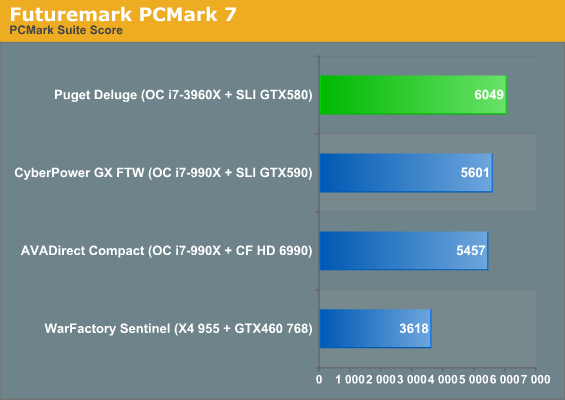
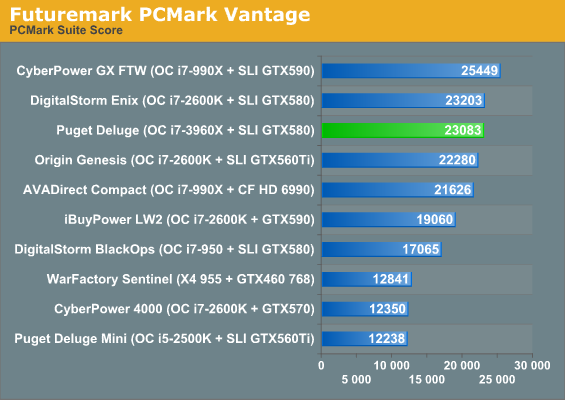
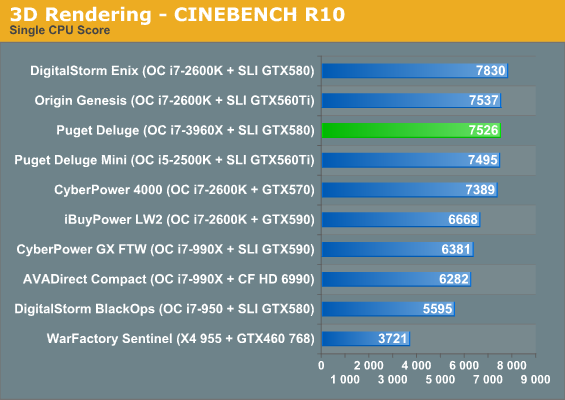
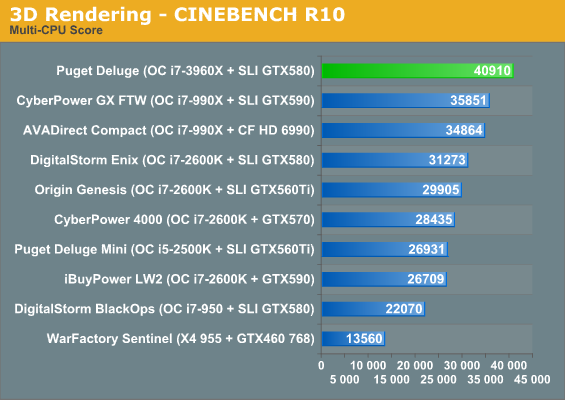
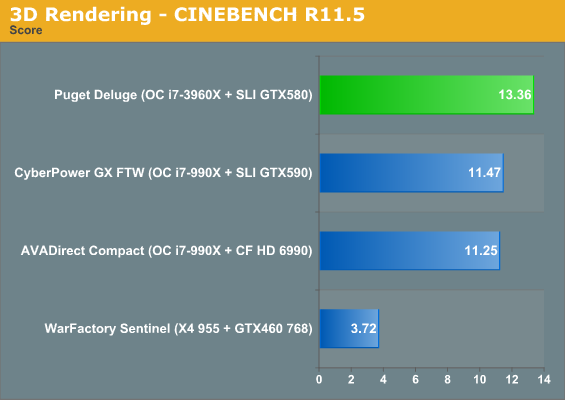
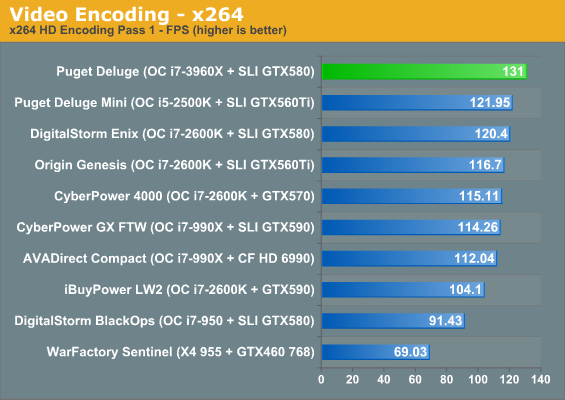
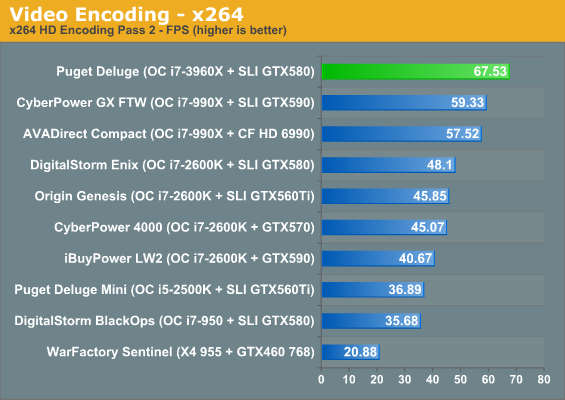
Generally speaking, the new X79 monster from Puget Systems takes the lead, but what's interesting is the comparison between the Deluge and the DigitalStorm Enix. The Enix is using a quad-core i7-2600K that's been overclocked to 4.7GHz, up 100MHz from the Deluge's i7-3960X's 4.6GHz. In places where SSD performance and graphics performance may also come into play, the Deluge actually has a hard time climbing to the top of the charts...which is where a $7,200 desktop really belongs. Still, particularly in heavily threaded workloads, Sandy Bridge-E can't be beat.
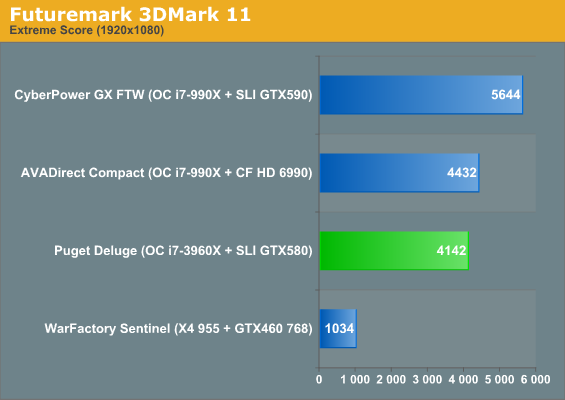
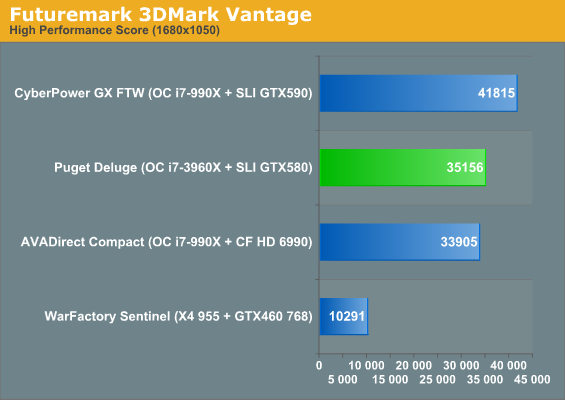

3DMark06 gets by on the increased CPU power, but Vantage and 3DMark11 are happier with the quad-GPU configurations we've tested. That's to be expected, but performance is pretty excellent and in Vantage the Deluge is even able to just barely best AVADirect's i7-990X-based system with a pair of AMD Radeon HD 6990s. Let's see how things pan out with some actual gaming tests.










72 Comments
View All Comments
Sabresiberian - Friday, November 25, 2011 - link
Okay' there aren't a lot of people that multibox, based on percentage of gamers (but there are probably more people that multibox than would actually spend $8000 for a computer), but if you are really going to talk about the gaming performance of a 6-core hyperthreaded CPU, shouldn't you be playing to it's strengths instead of just running single or dual core apps on it and saying "it's not any better"?Try running 5 WoW accounts at the same time and see what happens on rigs like this. Use a 2560x1600 monitor (at least). Turn the settings up to max - on all the accounts. You might see more of a spread in performance under those circumstances.
(If you did that, you would probably want to adjust the core affinities of the different accounts so they would be running on different cores).
(Not complaining about the article, just trying to look at it from a different viewpoint.)
;)
DigitalFreak - Friday, November 25, 2011 - link
Leeloo Multiboxprophet001 - Sunday, November 27, 2011 - link
I don't understand why people say that Sandybridge is bust? I've seen a lot of benchmarks on it and it seems to perform really well. While it has been noted that the x79 chipset is holding it back, I don't see why one wouldn't want to build a system with it? What am I missing?Menetlaus - Sunday, November 27, 2011 - link
Gaming people are saying it is bust because they were expecting bigger improvements with the additional PCI-e lanes, the 6X series chipsets are limited to 1-16x or 2-8x for graphics and there has been a lot of talk that 2-16x (a la x79, or gulftown the SB-E predecessor) would offer big improvements due to the extra PCI-e lanes.Sadly it was known that there is not a huge difference between 2-16x and 2-8x AND that more than 3 or 4 CPU cores does not offer much improvement in gaming, so it should not have been a surprise that the gaming people came away unimpressed by SB-E after the past year of SB goodness.
As you say there are places where SB-E works better than a quad core (rendering or other 100% usage scenarios), but this is a completely different usage from gaming, and the gaming group is a lot bigger and more vocal than the rendering shop guys.
Oldie - Sunday, November 27, 2011 - link
All of that money, all of that build quality, and they leave those ugly braided wires going right across the window?Toughbook - Monday, November 28, 2011 - link
It's a shame the interior shows of bare metal. How much could it actually have added to the production cost of each unit to have them painted, perhaps to the buyer's choice of color?Bare wires going thru holes in the chassis with no protection?
I would think the buyers of these units have a never ending amount of discretionary income. They see the price and think it's got to be the best because it's the most expensive. Or a business man tells his or her assistant to get the best desktop money can buy. Bingo! Do you think he might care or realize the short comings?
Thanks for the interesting review!
sedluk - Monday, November 28, 2011 - link
What the author of this review mixes up is what Puget Systems built vs. what Intel build. The X79/LGA2011 platform is expensive and does not add much value over much less expensive platforms. We can all agree on this. You still might want to pay a lot of money and have a X79 system, and if you do then the Puget Systems build is top notch. I have never owned a Puget Systems, but I respect the job they had done. It is not fair to fault them for something them for something Intel is responsible for.Beenthere - Tuesday, November 29, 2011 - link
While it's true the X79/SB-E is a poor POS hacked server system, $7K for this mess is obscene. For $3K I can build a better performing system so why would I spend $7K for this POS?Puke-It PCs must be good if they can actually sell these at $7K.
METALMORPHASIS - Wednesday, November 30, 2011 - link
For that price,you should be able to drive it down the street and back again as well as play games.BellFamily7 - Thursday, December 1, 2011 - link
A columnist from PC Mag (I forget who - not Dvorak) commented in ~1982 that "the computer you REALLY want always seems to cost $3,500."Adjusting for inflation (bls.gov has a good inflation 'calculator') $3,500 in 1982 is - ta-da! - $8,200 dollars in 2011.
Amazing - the "$3,500 Rule" still holds true.